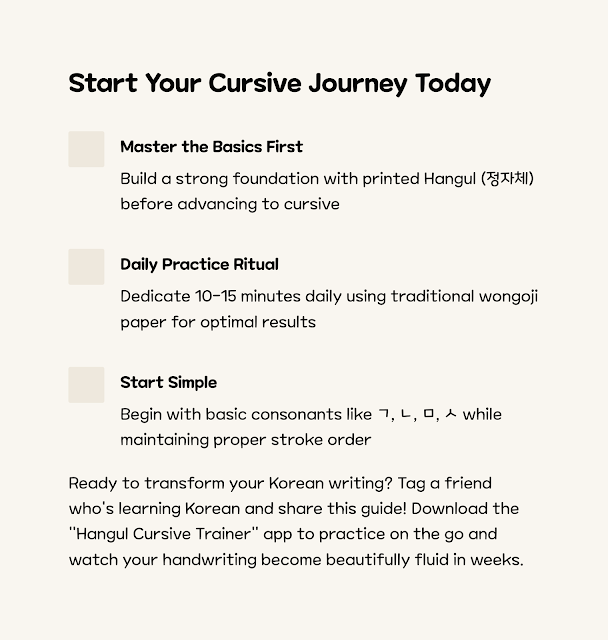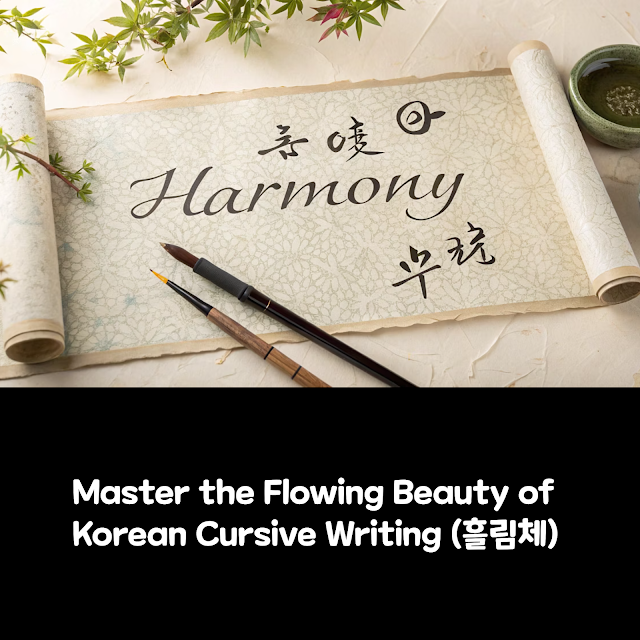Learn how to write beautiful Korean cursive (흘림체) with step-by-step tips, stroke simplifications, and personalized handwriting styles for beginners.
Mastering Korean Cursive: A Beginner's Guide to 흘림체
Learn the Artistic Flow of Hangul with Practical Techniques
Korean cursive writing, also known as 흘림체 (heullimche), blends speed and style into handwritten Hangul. While it doesn't have the same standardized form as English cursive, its fluid character appeals to those writing personal notes or journaling in Korean. Beginners often wonder how to transition from printed Hangul to a more natural and expressive form. In this post, you'll find a step-by-step guide to help you learn the key principles of Korean cursive, recognize common handwriting patterns, and develop your own flowing style of Hangul. We'll look at examples of cursive letters, stroke simplification tips, and beginner practice techniques. Whether you're learning Korean for the first time or aiming to improve your handwriting, this guide offers valuable insights for anyone wanting to master the visual elegance of Hangul.
| What is Heullimche? | A casual, flowing style of Korean handwriting used for personal notes. |
| Why Learn It? | To write faster, more naturally, and add personal style to Hangul. |
Learning to write Korean in cursive, or 흘림체, starts with understanding the structure of Hangul. Unlike Western cursive where letters are connected, each Korean syllable block maintains its form, even in faster handwriting. That means you’ll still write consonants and vowels in their standard block structure—but with a looser, more fluid touch. The key is to first master stroke order and then gradually loosen the structure while maintaining legibility. You don't need to memorize exact cursive forms because 흘림체 is highly personal and varies depending on the writer's flow and habits.
One of the defining features of Korean cursive is stroke simplification. For example, a consonant like ㄷ, which is usually written with two strokes, can become a single fluid motion. Circles like ㅇ may appear open or loose, and corners on letters like ㅁ can be rounded. The idea isn’t to rewrite Hangul completely but to smooth out transitions between strokes for speed and fluidity. Watching handwriting videos and analyzing font variations can help learners build a visual database of natural-looking cursive forms.
To truly improve in Korean cursive writing, create a daily routine. Practice each consonant and vowel in 2 to 3 different styles. Use squared paper (원고지) to maintain balanced syllable blocks. Start with writing your name, then move to common words. Over time, your hand will naturally adapt, making each stroke more fluid without sacrificing readability. Remember, style comes from repetition and experimentation.
| Stroke Simplification | Hangul Syllables | Cursive Practice |
| Reduce total strokes for speed while maintaining shape. | Syllables stay grouped even in cursive, not split by strokes. | Use 원고지 to structure each syllable neatly. |
| Merge curved strokes for fluidity. | Block structure is central to Hangul’s readability. | Repeat daily to develop speed and consistency. |
Korean cursive writing, or 흘림체, offers a perfect blend of efficiency and elegance. By understanding the structure of Hangul, practicing stroke order, and gradually adopting your own cursive variations, you can develop a personal style that is both beautiful and readable. The freedom of cursive lies in its personalization—there are no rigid rules, only what looks and feels natural to your hand. Take your time, enjoy the process, and celebrate each small improvement. Hangul's visual rhythm becomes clearer the more you write. So, pick up your pen and start your cursive journey today!

여러분의 의견을 들려주세요!
Did this guide help you understand Korean cursive better? Let us know your experience, challenges, or any additional tips you might have! We love hearing from fellow Hangul learners.
태그:
복사용 태그:



0 댓글